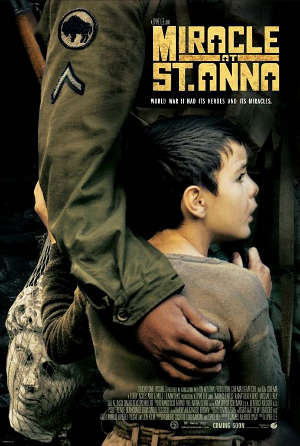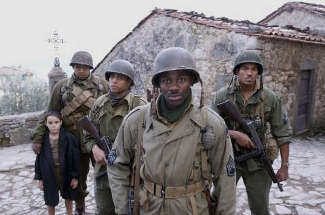- Title: Miracle at St. Anna
- IMDB: link

 The latest from Spike Lee is an adaptation of James McBride’s book itself inspired by events in Italy during WWII. A murder and the discovery of a priceless artifact lead to a tale forty-years before involving four African-American soldiers in a Tuscan village and a disturbed child, the lone witness to a monstrous act.
The latest from Spike Lee is an adaptation of James McBride’s book itself inspired by events in Italy during WWII. A murder and the discovery of a priceless artifact lead to a tale forty-years before involving four African-American soldiers in a Tuscan village and a disturbed child, the lone witness to a monstrous act.
Aside from the beginning scenes and the epilogue the majority of the film takes place in 1944 where four members of 92nd Infantry Division (Derek Luke, Michael Ealy, Laz Alonso, Omar Benson Miller) find themselves cut-off from their unit and trapped in a small Italian town in the Tuscan countryside surrounded by German troops.
The film is about secrets which are slowly unveiled to the audience, though not necessarily the characters, over the course of the movie. The discovery of the small child (Matteo Sciabordi) in 1944 who survived the Sant’Anna di Stazzema massacre and the murder and discovery of the artifact by the police at cub reporter Tim Boyle (Joseph Gordon-Levitt) in 1983, at the beginning of the film, are but two pieces of a much larger story.
There’s much here to discuss. The four main leads carry the film and Miller stands out for me playing the childlike Pt. Train who proves to be the perfect lens in which to view the events of the war, the disagreements between the men, the troubled young boy, and the need of faith in dire circumstances.
There are also many strong performances by Italian actors including Valentina Cervi as the beautiful Renata, Piefrancesco Favino as the illusive Buttefly, and Scalbordi as the scared and confused young Angelo. Much of the film was shot on location in Italy which allows for a natural look and feel to the film which green screens alone wouldn’t have accomplished.
Lee and writer James McBride (who adapts the screenplay from his own novel) craft an engaging and slowly developing tale that hold its secrets close to the vest. Some may be put off by the 160-minute running time, but Lee takes his time allowing events to flow naturally rather than forcing quicker action. Although the film does include some bloody battles, its the quiet scenes which carry the most weight and make up the bulk of the film.
 There are many memorable moments throughout the film, but I’ll discuss two. The first involves the stark revelation of the events at St. Anna which doesn’t flinch at the brutality on display. The second involves a prayer inter-cut throughout the various characters and groups and cobbled together for great effect (much like the various characters singing “Wise Up” from Magnolia). Both, in a film which is very good, are stand-outs and two of the most memorable moments from movies this year.
There are many memorable moments throughout the film, but I’ll discuss two. The first involves the stark revelation of the events at St. Anna which doesn’t flinch at the brutality on display. The second involves a prayer inter-cut throughout the various characters and groups and cobbled together for great effect (much like the various characters singing “Wise Up” from Magnolia). Both, in a film which is very good, are stand-outs and two of the most memorable moments from movies this year.
The story, and the film, is also influenced by the racism of the time. The 92nd Infantry, an all black segregated unit was still an experiment disliked by many officers during WWII. Although this influences the perceptions of the characters the main focus of the film is not on how these men were treated but what they were able to do on the battlefield. Only in one spot, during a flashback to soldiers early days, does the story itself seem to stop to allow for a somewhat forced message about the racial inequalities of the times.
Although thorougly engaging and incredibly well-made the film does have one or two flaws. At times the dialogue seems mumbled, especially early in the film, which makes following the storyline at times a bit too much of an adventure. My only other complaint is the ending which is the only place where Lee seems to rush rather than allow the story to naturally unfold. Given it’s already 2.5 hour running time its obvious why the epilogue is so short, but although the ending does include the right emotional impact the final scenes seem a bit bungled.
Movie critics see so much crap, and so many mediocre films, we sometimes jadedly forget that filmmaking can still be done with the skill and talent Lee presents here. While some may object to the liberties Lee takes with history it is important to note the film is based on McBride’s novel which is only loosely inspired by true events. What Lee gives us is an engaging and compelling tale, equal parts character study and suspense film. Simply put, Miracle at St. Anna is one of the best films of the year.
